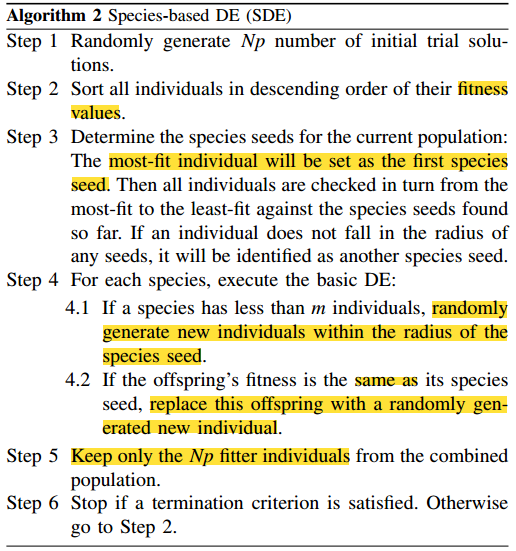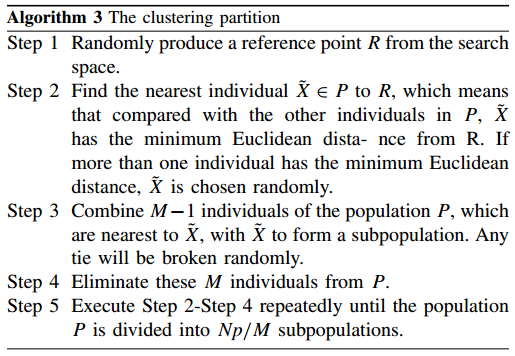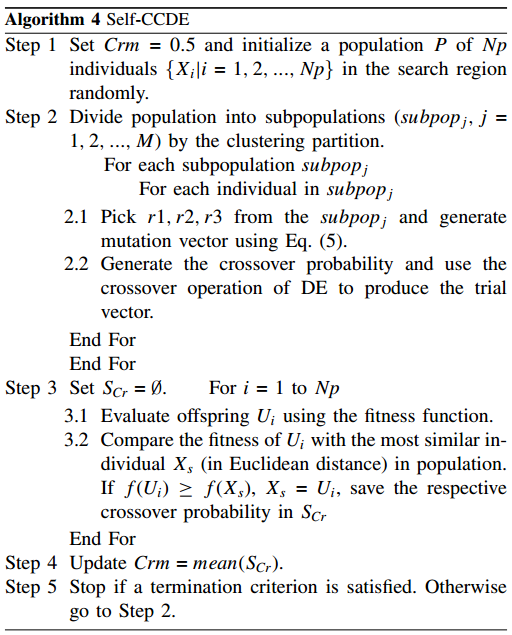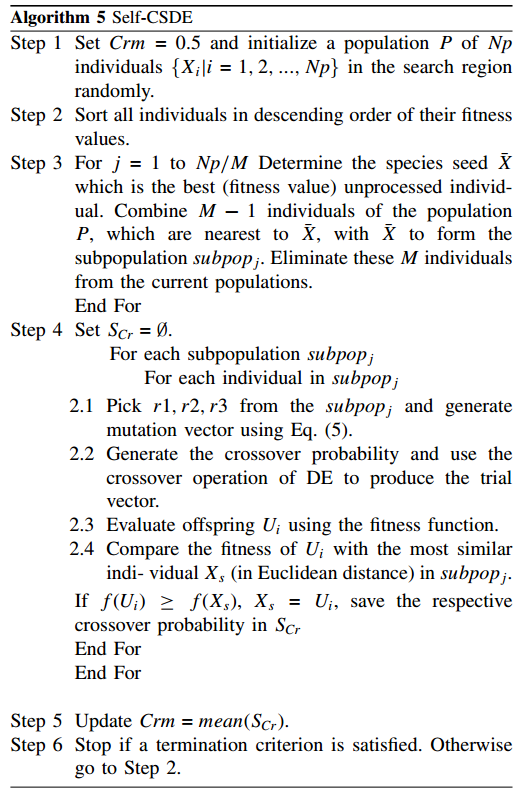文章目录
文献阅读:《A Cluster-Based Differential Evolution With Self-Adaptive Strategy for Multi-modal Optimization》
个人理解
-
使用聚类划分和自适应参数控制技术来解决多模态问题
-
CCN和SCN
- CCN根据欧几里得距离,在空间上进行划分小生境
- SCN将适应度降序排列,选适应度最高的个体x,并结合剩余M-1个与x的欧几里得距离最近的个体组成一个子种群
-
CDE和SDE
-
CDE用标准DE生成子代,并与当前种群中最相似的个体进行比较并选择保留更优的个体,是一种拥挤策略
-
SDE
-
不同的小生境由不同的物种种子形成,突变在物种内进行
-
把种群利用相似度分组,首先按照适应度排序,把第一个最优个体作为第一个种群的中心,其他个体如果和中心距离小于半径,则归纳到同一组,否则剩下的按照相同方式分组
-
对每个种群,执行全局DE:
如果一个种群数量小于m,那么随机生成新的个体加入其中,需要满足半径参数要求。
如果子代个体的fitness和species seed的相同,则用随机个体取代该子代个体
-
-
Abstract
- clustering partition
- divide the whole population into subpopulations so that different subpopulations can locate different optima
- self-adaptive parameter control
- enhance the search ability of DE
- the proposed multi-population strategy and the self-adaptive parameter control technique are applied to two versions of DE, crowding DE (CDE) and species-based DE (SDE), which yield self-CCDE and self-CSDE, respectively
Introduction
-
it is difficult for the basic DE to optimize multi-modal functions.
- The difficulty lies in how to locate multiple global and local optima and how to maintain the identified optima until the end of the search.
-
The diversity loss is mainly due to the mutation operation and the greedy selection scheme
- For multimodal optimization problems, it is important to guide individuals to move toward different promising subregions
-
multipopulation method
- enhance the diversity of the population, with the aim of maintaining multiple subpopulations on different peaks
-
The traditional methods of using the multipopulation to find optima divide the whole search space into local subspaces
- each of which might cover one or a small number of local optima, and then separately searches within these subspaces
- However, the difficulty is how to define the area for each subregion in the search space and how to generate subpopulations.
-
The convergence rate can be improved if the control parameters are adapted to appropriate values at different evolution stages of a specific problem.
-
this paper proposes a cluster-based differential evolution with self-adaptive strategy for multimodal optimization
- The proposed approach adopts multipopulation method for multimodal optimization problems to improve the search ability. The whole population is divided into subpopulations by the clustering method. The clustering partition can enable the algorithm to assign individuals to different promising subregions
- The proposed approach adopts a self-adaptive parameter control technique in DE. Due to the control parameters adapted to appropriate values based on different evolution stages, it can improve not only the convergence rate but also the accuracy
2 Basic DE and Related Studies
A、Differencial Evolution
- DE/rand/1




B、DE For Multimodal Optimization Problems
literature on DE for multimodal optimization can be mainly classified as two categories
(1) MultiPopulation Method
-
Clustering-based approaches are one of the most effective implementations of multipopulation methods
-
MMDE,multisolution multipopulation DE
- divide the population into equally sized subpopulations
- In each subpopulation, a general DE is applied for a given number of generations. After this, a migration process is implemented to maintain the diversity and avoid premature convergence. When a subpopulation converged, the found optima are collected into an archive
- However, it is possible that some optima are missed during a single search epoch if there are multiple optima close to each other
- To solve this problem, the repeated search epochs are used and each searching epoch is characterized by a specific resolution factor
-
MultiDE
- in MultiDE the number of subpopulations is kept variable, i.e., subpopulations can emerge and disappear
(2) Niching Technique
-
Sharing DE
- integrated the fitness sharing concept with DE
- utilizes the classical sharing technique, based on the Euclidean distance
- In each generation, the number of offspring is equal to the parent population size. Thus, after Np trial vectors have been generated from Np parents, the sharing function is used to calculate the fitness for each individual and the worst half of the population is eliminated
- requires defining a niche radius
- proposed to extend DE with a crowding scheme (CDE) to allow it to tackle multimodal optimization problems
-
CDE

- when an offspring is generated by using the standard DE, it competes only with the most similar individual (measured by Euclidean distance) in the current population
- The offspring will replace this individual if it has a better fitness value. To avoid replacement error in CDE, the crowding factor is chosen to be equal to the population size Np
-
用标准DE生成子代,并与当前种群中最相似的个体进行比较并选择保留更优的个体,是一种拥挤策略
-
Species-based DE (SDE)
-

-
Different niches are formed around the species seed. The mutation is carried out within each species
不同的小生境由不同的物种种子形成,突变在物种内进行
-
把种群利用相似度分组,首先按照适应度排序,把第一个最优个体作为第一个种群的中心,其他个体如果和中心距离小于半径,则归纳到同一组,否则剩下的按照相同方式分组
-
对每个种群,执行全局DE:
如果一个种群数量小于m,那么随机生成新的个体加入其中,需要满足半径参数要求。
如果子代个体的适应度和species seed的相同,则用随机个体取代该子代个体
-
C、Adaptive DE for Single Objective Optimization Problems
-
self-adaptive DE (jDE)
- During the evolution, the new F takes a value from 0.1 to 0.9 in a random manner with a probability τ1, the new Cr takes a value from 0.0 to 1.0 in a random manner with a probability τ2, and both of them are obtained before the mutation is executed
-
self-adaptive DE (SaDE)
- controlling the mutation schemes and parameters dynamically based on previous search experience
-
JADE
- using a new current-to-pbest mutation scheme to generate mutation vectors
- extracts information from the recent successful F and Cr and uses such information for generating new F and C
3 Proposed Algorithm
- two key components of the proposed algorithm
- the multipopulation management strategy
- the self-adaptive parameter control technique
A、Multipopulation Strategy
-
标准DE的随机突变和贪婪选择算法对于单目标优化有效,但不适用于多目标优化,会造成多样性的损失
-
多目标优化需要同时定位多个最优点
-
难点在于如何保持种群的多样性,使每个最优区域都有个体覆盖
-
we introduce a clustering partition to divide the whole population into a number of subpopulations, which cover different local regions, based on spatial positions of the individuals
-
First, the population of size Np is split into a group of disjoint subpopulations according to the location of individuals in the solution space, each of which comprises M individuals with adjacent location.
- Then, we use M individuals of each subpopulation to generate the same number of offspring by DE, which is likely to move the subpopulation toward near peak.
- The population P with size Np is clustered into a number of subpopulations with size M as presented in Algorithm 3

- 随机生成一个参考点R
- 找到与R最近的点X~,如果有多个同样近的点,就随机选一个
- 结合其他M-1个距离X~最近的个体,共M个来组成一个子种群,
- 将这M个个体从种群P中去除
- 重复2-4步,直到划分为Np/m个子种群
B. Self-Adaptive Strategy
-
自适应的突变算子和CR算子
-
how to make the algorithm quickly converge to the optima contained by different subpopulations
- develop a self-adaptive DE
-
mutation operation

- the second term in (5) is the guidance term, which controls the search direction
- is expected to offer an opportunity that the search moves toward promising direction
- because if f (Xr2 ) > f (Xr3 ), (Xr2 − Xr3 ) is in the promising direction to exploit, and if f (Xr2 ) < f (Xr3 ), the actually search direction is (Xr3 −Xr2 ), which is the promising direction to explore
- the new mutation operation realizes a self-adaptive parameter control strategy on F
-
adopt a simple self-adaptive strategy to dynamically update Cr
-
At each generation, for each target vector, the crossover rate Cri is independently generated according to a normal distribution of mean Crm and standard deviation 0.1

-
and truncated to the interval [0, 1], where Crm is the mean value to generate Cri. It is updated as follows

where mean() is the usual arithmetic mean operation; and SCr is the set of all successful crossover rates Cri at previous generations
-
C. Algorithmic Framework
-
cluster-based CDE with self-adaptive strategy (selfCCDE)

-
初始化含有Np个个体的种群
-
通过聚类划分将种群分为m个子种群
- 针对每个子种群中的每个个体,选择3个同一子种群的随机个体,生成突变向量
- 生成交叉概率并根据此概率生成试验向量
-
对于每一个后代Ui,评估其适应度
- 将其与最近欧几里得距离的个体Xs进行比较
- 若Ui的适应度比Xs好(说明有改进),则将Xs用Ui替换,并将此次成功的Cr值存入Scr
- 将其与最近欧几里得距离的个体Xs进行比较
-
更新Crm值
-
继续不断划分种群,演化直到达到停止条件
-
cluster-based SDE with self-adaptive strategy (self-CSDE)

-
随机初始化种群P
-
根据适应度降序排列
-
对于每个子种群确定一个适应度最好的个体作为种子X,并结合其他M-1个距离X最近的个体,形成一个子种群,并去掉这M个个体
-
对每个子种群的每个个体
- 随机选择3个个体并生成突变向量
- 生成交叉概率并据此生成试验向量
- 评估后代Ui的适应度
- 将Ui与其欧几里得距离最近的个体Xs比较
- 若Ui适应度比Xs好(说明得到了改进),就将Xs用Ui替换,并将成功的cr值存入Scr
- 更新Crm值
- 继续进行第二步,直到达到停止条件
Experimental Setting
略
Conclusion
-
clustering partition
-
a self-adaptive parameter control technique
-
the multipopulation strategy and the self-adaptive parameter control technique are applied to two versions of DE, CDE, and SDE, yielding self-CCDE and self-CCDE(即CCN和SCN), respectively
-
the subpopulation size M affects the performance of the algorithm to some extent
- How to design an adaptive strategy to control M through the evolution process calls for future work
- Future research may also focus on testing the performance of the algorithm on much more massively multimodal optimization problems with high dimensionality and constraints























 1905
1905











 被折叠的 条评论
为什么被折叠?
被折叠的 条评论
为什么被折叠?










